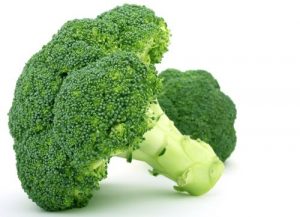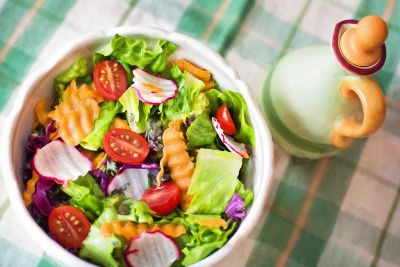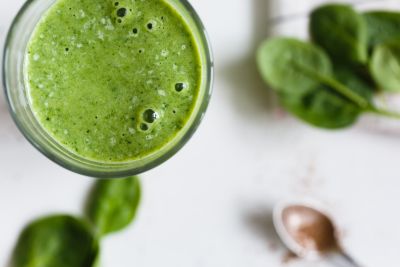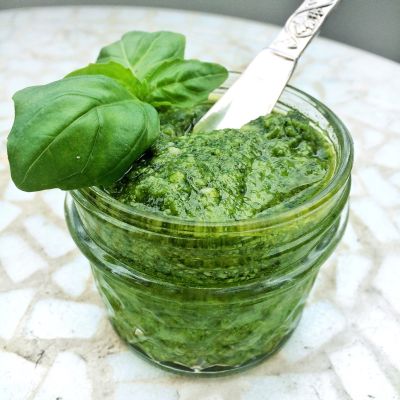Green is the color of life! Not without a reason, all the healthiest vegetables have this color … just why do they so rarely land on our plates? Look how easy and tasty can you supplement your daily meals with these robust plants.
WHERE TO FIND THEM?
Green is just one of the 5 colors of vegetables and fruits. Vegetables and fruits of this color, in general, detoxify and help to protect our body. They are low-calorie, but nutrient dense, i.e. they contain a lot of vitamins and minerals, so it is worth introducing them to the daily menu and „shove them in wherever possible”. The most popular greens include:
- VEGETABLES: Broccoli, brussels sprouts, zucchini, chicory, peas, snow peas, chinese cabbage, chayote artichokes, cucumber, okra, leek, rapini, arugula, cress, lettuce, celery, spinach, asparagus, Green cabbage, green onion, green bell peppers.
- FRUITS: Avocado, kiwi, lime, honey melon, green apples, green pears, green grapes.

WHAT VALUES DO THEY HAVE?
- NUTRIENT DENSITY – This is the nutritional value of the product with respect to its calorific value. The more given product contains necessary elements in a unit of energy, the higher its nutrient density and the more vitamins and minerals it provides. Green vegetables are mostly leaves that are among the most nutrient dense (a ranking of products with the highest nutritional density, developed by Dr. Fuhrman can be found here) – that is, it is much easier to fill the stomach with 500 calories of green vegetables than e.g. nuts or cheese (that are very calorie dense). The obvious benefit of this is that we do not overeat this way, by consuming too much calories, but we will feel satiety (because we have filled our stomach) and we will provide a large amount of vitamins and minerals.
- CALCIUM – it is the basic bone and tooth building material. It is also essential for proper cell function, is affects metabolism, muscle contraction and blood coagulation.
- FOLIC ACID – i.e. vitamin B9. It has many biochemical functions in the body. It is involved in amino acid metabolism, is essential in the process of new cells creation, regulates the action of the nervous system, participates in hematopoietic processes, prevents atherosclerosis and protects against parasites, ensures the efficient functioning of the liver, stomach and intestines.
- FIBER– helps to maintain proper weight by slowing down the absorption of carbohydrates, is a prebiotic, nourishes good bacteria in the digestive tract, lowers bad cholesterol levels, improves the appearance of skin, hair and nails.
- PHYTONUTRIENTS – They reduce the harmful effects of free radicals, neutralize harmful substances, have an anti-inflammatory effect, fight viruses, bacteria and fungi, promote hormonal regulation and reduce bad cholesterol.
- CHLOROPHYLL– It has a cleansing properties, improves the oxygenation and nutrition of all cells, supports the immune system, improves the functioning of the entire digestive system.
- ANTIOXIDANTS– neutralize free radicals, delay aging and protect against cancer.
- LUTEIN – It protects against UVA and UVB radiation, improves hydration and elasticity of the skin, normalizes the work of sebaceous glands.
HOW TO EAT THEM?

SALADS – salads create an infinite set of possibilities, and green vegetables (especially leaves) provide a great base here. They add volume (e.g. kale, lettuce, Chinese cabbage), so we think we ate a huge meal composed of them but the calories are still be under control. They can also be a tasty additive (arugula, lamb’s lettuce, parsley or other herbs), enriching the taste and adding lightness to our favorite salads, additionaly slipping inside a little more nutrients. It’s a mandatory supper item for those watching their weight.
 SOUPS – we can turn many green vegetables into tasty cream soups (brussel sprouts, kale, broccoli, asparagus) – e.g. broccoli, green peas or asparagus cream soup. They can also be a great „additive” for more clear soups (plain and sugar peas, brussel sprouts), so it will be more filling and sometimes enrich the experience, because there can be something to munch in the soup. Each soup can also be sprinkled with parsley or coriander, enriching it visually, but also adding aroma and some life-giving ingredients.
SOUPS – we can turn many green vegetables into tasty cream soups (brussel sprouts, kale, broccoli, asparagus) – e.g. broccoli, green peas or asparagus cream soup. They can also be a great „additive” for more clear soups (plain and sugar peas, brussel sprouts), so it will be more filling and sometimes enrich the experience, because there can be something to munch in the soup. Each soup can also be sprinkled with parsley or coriander, enriching it visually, but also adding aroma and some life-giving ingredients.

SHAKES AND SMOOTHIES – the most simple and interesting way to consume green vegetables! Just blend them with your favorite ingredients (fruits, vegetables, oatmeal, etc.) and water or milk (preferably plant one). When blended, they are shredded and easily digested. In addition, we can fit in a lot more components in this form than in a solid one. They will do well before or after workout or as a lunch. Vegetables contain a lot of fiber that regulates blood sugar. Smoothies give you virtually unlimited possibilities for creating new variations of taste and consistency.
 PESTO – a great way to eat fresh herbs. Pesto consists of green leaves (parsley, coriander, spinach) crushed with good quality olive oil and selected nuts (pistachios, cashews, pine nuts) or grains (sunflower, sesame). We can use them as a sandwich spread or instead of a sauce for your favorite pasta, rice or groats.
PESTO – a great way to eat fresh herbs. Pesto consists of green leaves (parsley, coriander, spinach) crushed with good quality olive oil and selected nuts (pistachios, cashews, pine nuts) or grains (sunflower, sesame). We can use them as a sandwich spread or instead of a sauce for your favorite pasta, rice or groats.
If you find this article interesting, share it with others using the social media buttons below the text. If you don’t want to share, maybe at least like it? :-)



